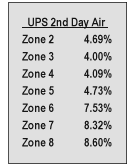The 2008 parcel rate increases will, collectively, be the largest in recent memory. Matching United Parcel Service’s pricing last year, the three carriers will increase rates for both express and ground services by an average of 4.9%.
The carriers usually announce these rates as an average increase, which means that the actual impact will vary widely depending on different variables. As a shipper, you should carefully look at each individual increase and compare it to your own demographics to fully understand the affect it will have on your budget. This can be a time-consuming process, so here’s some information to give you a better understanding of the new rates.
First of all, express rates are being announced by the carriers as an increase with a net impact of 4.9%. But it’s actually a rate increase of 6.9%, combined with a 2% fuel surcharge reduction. Paying 2% less for fuel is a nice break for shippers facing volatile prices. But because fuel is, in fact, volatile, these costs will fluctuate at the same rate they always have. This means that if fuel costs go up, regardless of the 2% fuel surcharge reduction, your shipping costs will go up as well.
For a better idea of what the rates will look like across all services, we’ve broken out the average rate increase by each service level across zones 2–8. Although these rates are based on the pricing announced by UPS last month, rates from both FedEx and DHL will most likely be similar.

As you can see, the actual rate increase across each service varies significantly and—depending on your individual shipping characteristics—the overall impact could be much higher than the 4.9% increase announced by the carriers.
But as you dig deeper into each individual service, you will see that the rates will continue to vary based on other factors as well. For example, ground shippers will need to pay close attention to package weight, as this will play an important role in the overall increase. Although pricing does vary on both weight and distance, the rates for packages that fall below 10 lbs. will be much higher than for packages that fall within most other weight ranges.
The following chart is the average rate increase for UPS ground service at each weight break across zones 2–8.

Based on this information, you can see that the rates will be above the published 4.9% increase if your shipment weight is 10 lbs. or less.
And because it is more expensive to send a package by air–especially with the rising costs in fuel–the price will increase at a greater rate for express shipments sent to farther zones, which is when these services are most commonly used. For example, in the following chart, we took the average increase for packages in the 1-10 lbs. range sent second-day air across each delivery zone.

Based on our analysis, the rates rise significantly at zones 6–8, and are much higher than the 4.9% average increase announced by the carriers.
Another area to carefully examine is accessorial surcharges. You should obviously examine each surcharge carefully since these rates can have even more of an impact on pricing, depending on your shipping parameters. But two accessorial surcharges that are worth mentioning include Residential Adjustments, which will go up 5.4%, and delivery area surcharges, which will increase by 7.1%.
With the exception of size, the way the parcel rate increases were announced for 2008 is nothing out of the ordinary. What’s more important are the steps that you take to minimize the impact these rates will have on your shipping expenditure. This requires a thorough review of each individual rate increase, along with a complete understanding of your own individual shipping characteristics, to determine what can be changed to lessen the cost.
Jeff Jolin is marketing communications manager for Andover, MA-based logistics optimization services provider Birddog Solutions.